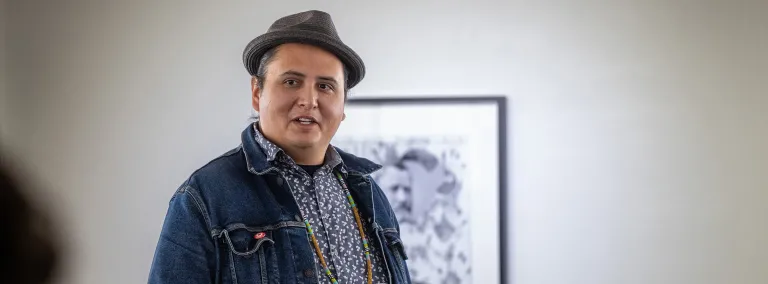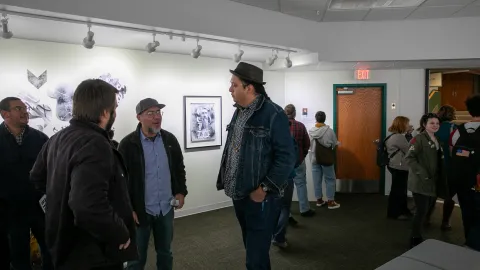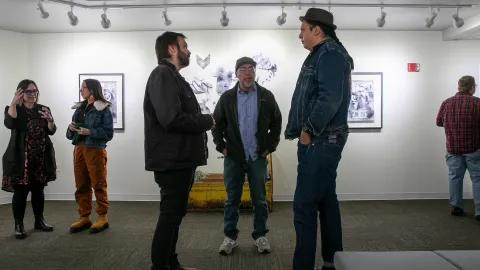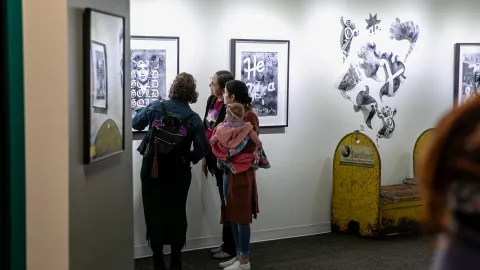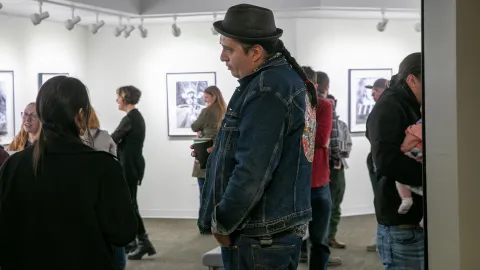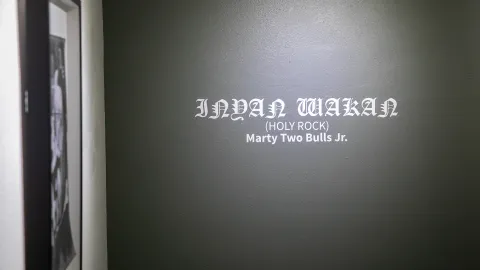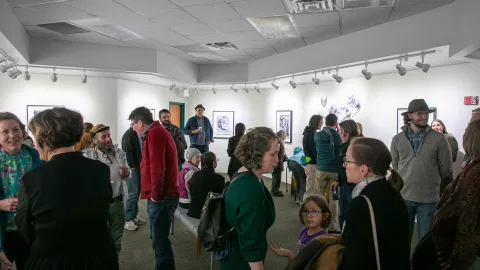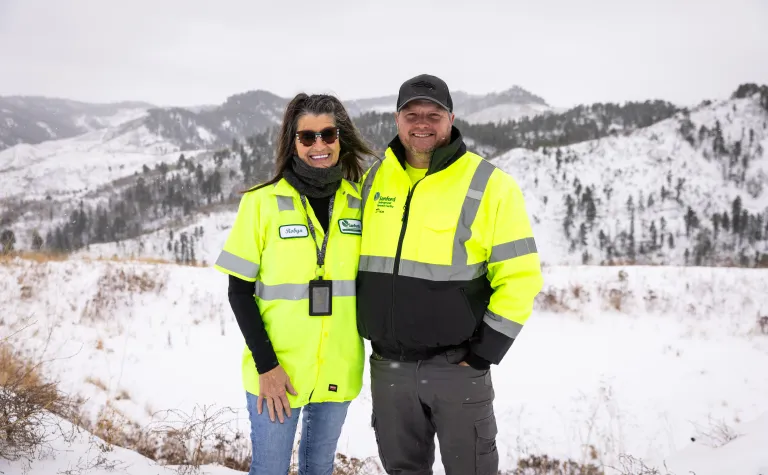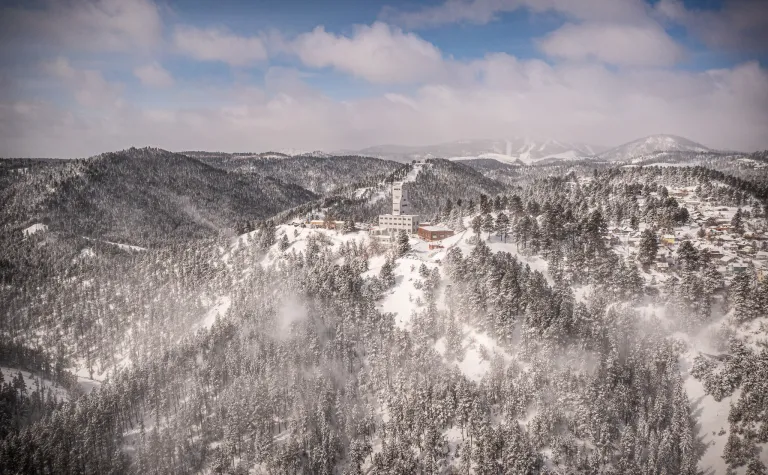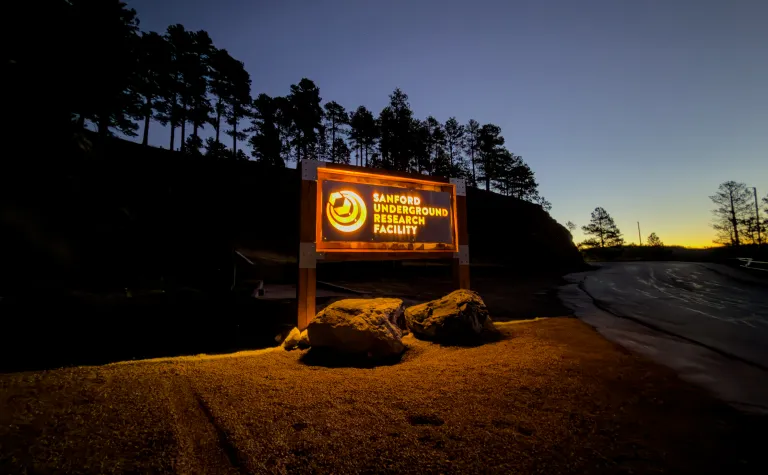Marty Two Bulls Jr., SURF’s 2024 AiR, presents Inyan Wakan at Ruddell Gallery
This exhibit was inspired by Two Bulls' time as an Artist in Residence at SURF
In Lakota, Inyan Wakan translates to holy rock. It’s the name of the art exhibit Marty Two Bulls Jr. chose to showcase his experience as an Artist in Residence (AiR) at the Sanford Underground Research Facility (SURF).
Two Bulls, an enrolled member of the Oglala Sioux Tribe, is an incredibly accomplished and award-winning artist. His work has appeared in galleries across the United States and around the world. Following his 2011 graduation from the Institute of American Indian Arts in New Mexico, he spent several years in Santa Fe developing his art practice. He then spent eight years as a fulltime faculty member at Oglala Lakota College, where he founded a graphic design program. Today, Two Bulls is transitioning from his work at the college, by serving as an adjunct faculty, as he moves towards a fulltime focus on his art practice.

Photo by Matthew Kapust
The show in Spearfish is a bit of a homecoming for Two Bulls. While his work has appeared internationally to great acclaim, this is the first time he has held a solo exhibit in the Black Hills.
“I haven't had a solo show this close to home. I don't think ever. So, it's really nice to have my community here and my friends and my family,” Two Bulls said.
The exhibit is primarily mixed media works on paper. The framed objects include layers of paper stab bound together that feature photographs, drawings, symbols, lettering, and that are all rendered with charcoal, lithograph, and other mediums. The pieces show both symbols important to Lakota culture and math, chemistry, and physics equations pertinent to the ongoing research at SURF. Some of the upper layers have shaped cut outs that allow the viewer to see to the layers below.
“I wanted that depth and dimensionality to these works,” Two Bulls said. Part of that depth includes a Japanese book binding process that stiches the layered artworks together. “I was kind of thinking of these pieces almost like books. Books of knowledge. If they weren't framed, you could pull them out and page through. But inside the closed frames, some of the things drawn here are obscured,” he said.
The exhibit also includes two-person car benches that were once part of an underground locomotive at SURF, along with cores of rock drilled when the Homestake Mine was in operation, that show the layering of rock underground at SURF.
“Marty has stacked and layered deeply thought-provoking images and ideas together. The work is skillful and emotional. I appreciate this work for its complexity and depth,” says Gina Gibson, a professor of digital communication at Black Hills State University who served as SURF’s first AiR and coordinates the program today.
For Two Bulls, the complex layering in this body of work, is part of the complexity of SURF itself. This includes the deep geologic history of the site and the Lakota’s deep connection to the Black Hills—a place indigenous people have considered sacred for millennia. One piece is related to the 1872 mining law, another the 1876 Custer Expedition—which opened the floodgates to gold mining in the Black Hills and broke treaties with the Lakota. The works are also inspired by the labor of thousands of miners who spent 125 years digging and blasting out North America’s deepest gold mine and the more recent history of science that laid the foundation for the creation of a world-class underground laboratory.
“So, there's a lot of complicated history and layering in this work and I always intended these works to show as a group,” Two Bulls said. “To understand this work, and its relation to this complex history, you have to look at everything and experience it as a whole."
Two Bulls’ work also explores the transition from the mineral extraction of the past to the extraction of knowledge today. One of his works features Ray Davis, a chemist, whose underground research on neutrinos won him the Nobel Prize and Fritz Zwicky, an astrophysicist, who first proposed the concept of dark matter in the 1930s.

Photo by Matthew Kapust
“So much of the physics research is trying to create this equation that explains the universe. The work of the physicists I met at SURF started to remind me of a creation story,” Two Bulls said. “Their work reminded of the way my people center the Black Hills in our own creation story. Yes, they are different stories, and different ways of understanding the universe, but I think we still come from that same sort of universal impulse to answer basic questions. Who are we? Where are we from? Where are we going?”
The exhibit, Inyan Wakan, is now showing at the Ruddell Gallery on the campus of Black Hills State University in Spearfish. It runs through the middle of December. The annual AiR program at SURF is a collaboration between Black Hills State University and the facility—the process for selecting the 2025 AiR is now underway at SURF and the program has a record number of applicants from around the world.
